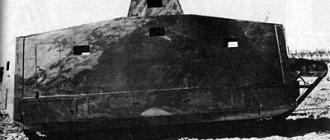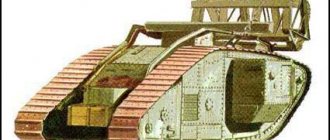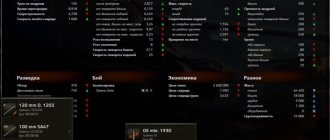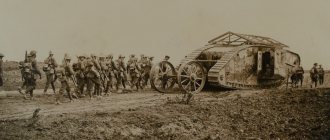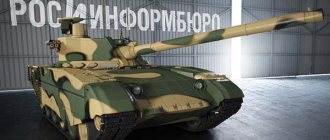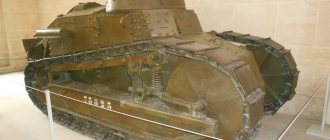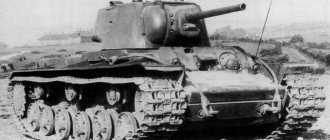The hundred-year history of world tank building is a continuous search for the most effective solution to a triune task: creating maximum firepower of a tank, ensuring its reliable armor protection, improving the speed and maneuverability of a combat vehicle.
This process, in which Russian tanks are an active participant, forces manufacturers to constantly look for new technical solutions, monitor the results of scientific research, take into account experimental test data, and try to apply all this before others to create and improve armored vehicles.
From the history of tanks
Attempts to combine the three main actions of any battle - attack, defense and maneuver - have been made at all times. There are any number of historical facts confirming this. The tank meets all these requirements.
The first English tank in the world is considered to be the MK-1 (Mark 1). On September 15, 1916, in the Battle of the Somme River, several of these vehicles, terrifying with their appearance, ensured a convincing victory for the British. At the same time, the losses in personnel turned out to be 20 times less than the “calculated” ones.
In fairness, it should be noted that in the history of tank building the names of domestic inventors have been preserved - Lebedenko, Porokhovshchikov, Stechkin, Mikulin.
Tank by Leonardo da Vinci
At the end of the 15th century, the great Leonardo da Vinci (see interesting facts about Leonardo da Vinci) managed to design a tank made of wood and metal. It was shaped like a spinning top.
The inventor placed cannons along the perimeter of the circle. Such an unusual machine had to be driven through complex mechanisms. This allowed the Renaissance tank to move across the surface autonomously.
However, Leonardo's ideas were so ahead of the time in which he lived that the project remained only on paper. An interesting fact is that in 2009, American engineers were able to recreate the tank according to the drawings of the great Italian.
New weapons of the First World War
The British government, having received information about the success of the new weapon, intensified work on the creation and production of tanks.
During the First World War, England produced more than 3,000 tanks of 13 modifications.
France did not lag behind its Entente allies. It was she who owned the most successful Renault FT tank at that time. It was armed with a machine gun (from 1917 - a cannon). It weighed 6 tons, had a crew of 2 people, and had a speed of 9.6 km. The Renault FT became the prototype for many other tanks and was in service with the French army until the early 30s.
As for other countries that later became tank manufacturers (Russia, Germany, the USA), their contribution to the creation of new weapons during the First World War came down to attempts to modify English and French models purchased or captured in battle.
Little and Big Willie
Little Willie was an armored tractor that was successfully tested in September 1915. The idea for its creation was expressed by British Colonel Swindon.
However, the armored vehicle had to be slightly modified, as a result of which the tank turned into Big Willie or the Mark I tank. It can rightfully be considered the very first tank in the world to be mass-produced. The Mark I was sent to the front line in 1916.
The Mark I was 8 meters long. It was made in the form of a steel rectangular box, which had diamond-shaped tracks on the side. This design allowed the combat vehicle to overcome difficult areas on the battlefield and move through trenches with ease.
Armor with a thickness of 10-12 millimeters served as protection against rifle and machine-gun fire. The armament of the tank itself consisted of one cannon and four machine guns. Moreover, only the “males” of Big Willie had such weapons, while the “females” were deprived of guns and had fewer machine guns.
The inside of the tank looked like a ship's wheelhouse. You could walk in it without bending over. The commander and driver of the tank were located in a separate compartment. Starting Big Willie's engine required the strength of three people to turn the crank until the engine started.
Mark I could move at a speed of 6 km/h. On rough terrain, the car moved at a much lower speed - 2-3 km/h. Even despite the low speed of movement, the tank shook terribly - this was due to the fact that the armor part was made of road wheels. There were no means of communication provided. In addition, the reliability of the tank design was too low, and the vehicles often broke down. Also considered a disadvantage of Big Willie were the narrow tracks, which quickly sank into soft ground, causing the tank to be stranded. There was no ventilation inside, which is why the soldiers had to often (even under machine gun fire) jump outside to breathe fresh air and take a break from the smell of exhaust fumes.
Despite all the shortcomings, the tank was actively used at the front - 18 such combat vehicles were used in the 1916 battle. After this, a demand came to London that such tanks be delivered to the front line in the amount of 1000 copies. Subsequently, the design of Big Willie was improved each time, and the more modern model was significantly ahead of the previous one in technical parameters.
Between two wars
This period did not become a breakthrough for the creators and manufacturers of armored vehicles, although the tanks of England and France did not remain out of competition for long. Other countries (USSR, Germany, Italy, Czechoslovakia, Japan, Poland, USA, Hungary, Sweden) gradually became involved in the process of creating new types of weapons.
However, tank building did not develop rapidly. Even a brief analysis of the work of designers and manufacturers of armored vehicles in the 20-30s allows us to highlight its main directions:
- development and production of inexpensive, light tanks and wedges with 1-2 crew members;
- the creation of light, maneuverable reconnaissance tanks, with improved weapons and protection compared to tankettes;
- a separate direction was the development of a reconnaissance amphibious tank;
- the creation of wheeled and tracked models, caused by the need to move machines from one site to another. But soon, instead of these complex systems, more durable tracks were developed.
It is easy to see that the main trends in the development of armored vehicles in the 20s and early 30s. boiled down to the development of light, cheap and easy-to-control combat vehicles.
The economic crisis of the post-war years and the disbelief in battle tanks of a certain part of people from power structures, including the military, had an impact.
Great Britain
The work of companies producing tanks in the UK was greatly influenced by the debate that developed in the military department between supporters of cruising (fast, light, maneuverable, but easily vulnerable and weakly armed) tanks and infantry (heavy, with good armor protection and strong weapons, but insufficiently maneuverable) machines.
The victorious supporters of the first, but incorrect, option led to the fact that by the beginning of the Second World War, the British Army had mainly light and cruising tanks in service.
Things were no better for another manufacturer of the first armored vehicles. If the British gave the tank crews of the British Army a Vickers 6t instead of a good tank (the license for its production was sold) They massively supplied the cheap Carden-Lloyd wedge, but the French continuously tried to improve the already well-known Renault FT.
As a result, France approached the Second World War with an army equipped mainly with light tanks and old Renaults.
"Leclerc" of the French army
The Russians did not have tanks in the modern sense until, during the Civil War, several French Renault FT-17 vehicles were captured near Odessa - the first tanks of the classical layout with a rotating turret. They were brought to the Sormovo shipbuilding plant, and the Nizhny Novgorod residents, having studied the samples down to the last screw, created a series of “Russian Renaults” that almost exactly repeated the original. Now Russian tank builders no longer need to borrow the ideas of their foreign colleagues: in the history of domestic tank building there is the T-64, the world's first serial main battle tank with the protection and armament of a heavy one and the mobility of a medium one and a combination of armor, as well as the T-35, the world's only serial heavy tank multi-turreted tank. French designers also have something to be proud of: their main battle tank AMX-56 Leclerc remains one of the most advanced.
AMX-56 “Leclerc”
There are more than 400 Leclercs in service with the French ground forces, and over 380 more in the army of the United Arab Emirates, which provided financial assistance to the developers for further purchases. Like the American Abrams, Leclerc is named after a World War II general: Marshal of France, Count Philippe de Hautecloque, took the nickname in memory of the 18th century military leader, division general Charles Leclerc. Continuity is also observed among Leclerc cars: when the AMX-30 became obsolete in the mid-seventies, its best characteristics were taken into account when implementing the national project to create the Leclerc. From 1986 to 2004, the tank went through ten modifications, and for the last two years another modernization program has been ongoing, thanks to which France will be able to keep its Leclercs in service until 2040. The peculiarity of the AMX-56 model is its enhanced protection system, which is successfully combined with the mass.
Germany
The Versailles Peace Treaty of June 28, 1919 introduced for defeated Germany strict restrictions on the production of many types of military equipment and weapons. Including tanks. Despite the ban, even before the Nazis came to power, the Germans secretly, under the guise of producing tractors, began developing and producing light and medium tanks.
When Hitler came to power, he simply ignored the Treaty of Versailles. Beginning in 1934, German tanks (light Pz-I, a little later Pz-II and medium tank Pz-III) began to enter service with the army.
True British "Challenger"
Prototypes of tanks, armored vehicles, appeared before the First World War in Great Britain, France and Germany, and then were transformed into armored boxes, first on tractors and then on caterpillar tracks. The British Challenger was created in the 1980s based on an export version of another British tank, the Chieftain. It was equipped with Chobham combined armor, which later became the prototype of the armor for the American Abrams. The tank was produced until 1990, and in 1993, at the Vickers factories in Newcastle and Leeds, they began producing the Challenger 2 - a modification of the first model, which the same company developed on its own initiative back in the mid-eighties. A year later, Challenger 2 was field tested and entered service with the British Army.
"Challenger"
Challengers 2 has innovative digital targeting systems from General Dynamics, with which a trained crew can fire up to seven accurate shots per minute. The tank also has day and night surveillance equipment and rifled long-range guns, the range is almost 500 kilometers, and their armor, like that of other tanks, can withstand even the impact of a cumulative projectile. Like the first Challengers, the second ones are heavy and clumsy, and the last vehicle entered service more than ten years ago, but they are planned to be used until 2035. It is interesting that the world is accustomed to calling “Challenger” not a British tank, but a NASA space shuttle. As you know, in 1986 it crashed off the coast of Florida - at the same time that Challenger 2 was just beginning to enter service. They, by the way, remain the only modern tanks with a rifled gun: another manifestation of the famous British conservatism.
Soviet Union
For objective reasons, Russia was the last to join the list of tank-producing countries. The military department of Tsarist Russia was not interested in this topic. In the fall of 1919, the first step was taken.
The Council of Military Industry of the RSFSR decided to create a Soviet tank based on the French Renault.
On August 31, 1920, the first tank “Freedom Fighter Comrade Lenin!” came out of the gate. A total of 15 tanks were produced, whose characteristics were not inferior to similar models from other countries.
The further development of armored vehicles in the country was so active that it would only be reasonable to briefly outline the milestones of this path:
- January-February 1928 - the beginning of mass production of the MS-1 (T-18) tank - small, escort. The first production tank. Participated in battles on the Chinese Eastern Railway;
- 1931 – 1932 – creation and serial production of T-26 and BT-2 tanks. Until the beginning of the Great Patriotic War, there were models that were the main battle tanks of the Red Army;
- 1930 - 1933 - following global trends, the two-seater T-27 tankette and the T-38 amphibious tank were launched into production;
- 1931 is the first year of mass serial production of tanks. 740 units of equipment were produced. For comparison, in 1931 – 170;
- decade 1931-1941 Historians call it the period of creation of a complex of armored vehicles. The massive development of tank models of all categories made it possible by the beginning of the Great Patriotic War to have a number of models that later became “weapons of victory.”
- mid - late 30s the Leningrad Kirov Plant (LKZ) is developing a model of the KV heavy tank, the decision to mass produce which was made at the end of 1939;
- The 76 mm tank gun on the KV was replaced with a 152 mm M-10T tank howitzer. The new combat vehicle received the KV 2 classification. The KV tank became known as the KV 1;
- September 1938 - the design bureau of the Kharkov plant was tasked with creating the A-20 light tank. The plant's designers, led by M. Koshkin, proposed their own version - the A-32, which later became the T-34 medium tank. The first use of sloping frontal armor, the V-2 diesel engine, the 76-mm F-34 cannon, and the Christie suspension—all this together made the medium tank the best for that time.
Israeli "Chariot"
The name of the Israeli tank "Merkava" translated from Hebrew means "Chariot", and the reason for its creation - one of the most interesting in the history of tank building - was the cancellation of the deal. After Great Britain refused to sell its Chieftains to Israel in 1970, it was decided to begin developing its own model of the tank, and since then the tracked Chariot has gone through four stages of modernization. The fifth version of the Merkava is planned to be put into development, equipped with a laser cannon and tested in 2020, however, the fourth model cannot be called imperfect - for example, a clear advantage remains the engine location in the front to protect the crew, and not in the rear, as most tanks.
"Merkava"
The uniqueness of the current version of the Israeli tank lies not only in the location of the engine, but also in the additional compartment with an armored door in the rear: in this “pantry” you can transport the wounded, troops, and ammunition, and in case of danger you can go out through it. Essentially, the Merkava is a hybrid of an armored personnel carrier, an infantry fighting vehicle and a tank. Although Israel is a fairly small country, the IDF is one of the most combat-ready armies in the world, and the Israelis are second only to the United States, Russia and Germany in terms of military exports. As for tanks, the Merkava has high ratings from professionals: in the well-known tank rating of the Forecast International agency, the Israeli Chariot even surpassed the legendary Russian T-90 tank.
During the Great Patriotic War
The war became a bloody “competition” between German and Soviet tank building. During it, both the Red Army's combat vehicles and German tanks were constantly improved. Often, changes in the combat and technical characteristics of Soviet tanks became the motivation for intensifying the work of German armored vehicle manufacturers. And vice versa.
Thus, the Red Army, having in service at the beginning of the war a small number of medium tanks T-34, heavy KV and light T-40 (mainly the units were equipped with T-26 and BT-2), after the first battles practically abandoned light tanks.
By the end of 1941, the KV-2 was discontinued and all attention was focused on the production of the T-34.
But with the advent of heavy tanks “Panther” and “Tiger” by the Germans, the need for heavy tanks returned. In 1943, the IS-2 heavy tank, nicknamed the “Tiger Fighter,” entered service. The table shows some tactical and technical characteristics of the main tanks of the Red Army and the Wehrmacht during the war.
| Main characteristics | T-34-85 | TV Panther | IS-2 | T-VI Tiger |
| Combat weight (t) | 30,1 | 44,8 | 46 | 57 |
| Crew (persons) | 4 | 5 | 4 | 5 |
| Dimensions (mm): | ||||
| length | 5920 | 6870 | 6770 | 6316 |
| width | 3000 | 3270 | 3070 | 3705 |
| height | 2405 | 2995 | 2630 | 2930 |
| clearance | 400 | 560 | 420 | 470 |
| Armor thickness (mm) | 52/30 | 90/30 | 100/30 | 100/40 |
| Gun caliber (mm) | 85 | 75 | 122 | 88 |
| Ammunition (shells) | 77 | 81 | 28 | 92 |
| Machine guns | 2x7.62 | 2x7.92 | 3x7.62; 1x12.7 | 2x7.92 |
| Engine (hp) | 500 - diesel | 700 - carburetor | 520 - diesel | 700-carburetor |
| Speed | ||||
| Highway (km/h) | 54 | 55 | 37 | 44 |
| Off-road (km/h) | 36 | 30 | 15-20 | 20-25 |
| Cruising range (km) | 380 | 250 | 160-240 | 100-195 |
| Firing range (m) | 4000 | 4000 | 4000 | 4000 |
It would be wrong to simply compare numbers. The approach must be analytical. For example, we must take into account that by German standards the Panther is a medium tank, but by the parameters accepted in the world it is a heavy one.
Armored train on tracks
In the 19th century, Edouard Bouyen's tracked armored train was introduced, which became the prototype of the world's first tanks. According to the inventor's idea, tightly connected trains were supposed to move not on rails, but on a closed caterpillar belt.
The train was supposed to be equipped with powerful guns, and the crew size could reach 200 people. And although Bouyen’s brainchild was never created, the scientist believed that such a train could radically change the philosophy of war.
When cars began to be produced at the beginning of the last century, the first tanks began to be developed at the same time. At this time, armored vehicles were very popular.
However, their disadvantage was that they were practically unable to overcome obstacles in the form of trenches, vegetation or barriers.
Armored train Buyena
When machine guns, anti-personnel mines and other projectiles began to be used in military conflicts, engineers had to think about creating a machine that could not be stopped by any type of weapon.
Tanks of the Cold War
The post-war international situation did not diminish the importance of the “main striking force of the ground forces.” The composition of the main countries producing tanks has partially changed. In the forefront were the USSR and the USA, at the head of the Warsaw Pact and NATO, respectively.
US tanks, represented by the M3 Stewart model created in 1941, became known only because they were delivered to the USSR, England, France and China under the Lend-Lease system.
Having abandoned light tanks, the Soviet military command directed the efforts of the tank industry towards bringing together heavy and medium vehicles.
In the 50s - early 60s. medium tanks T-54, T-55, heavy IS-4, T-10, T-10M, and the main one at that time, T-62, equipped with a 115 mm smoothbore gun, were adopted. Soon the production of heavy tanks was abandoned, leaving existing vehicles in long-term storage.
Late 60s – early 70s. for armored forces were marked by the appearance of three competing models: the Kharkov T-64, the Nizhny Tagil T-72 Ural and the T-80 manufactured at the Kirov plant in Leningrad.
The creators of all three models, continuing the best traditions of domestic tank building, worked to solve the classic triune problem:
- increased firepower - the tanks are equipped with 125 mm cannons, and the use of tank guided missile systems is provided;
- increasing the maneuverability of combat vehicles - T-64 engine -700 hp, T-72 - 840 hp. and the world's first 1000 hp gas turbine engine. installed on T-80;
- enhancing survivability and crew protection by increasing armor power is not relevant. The presented models and their modifications are equipped with dynamic protection “Contact”, active protection complex “Arena”, KOEP “Shtora”.
Since 1976 The T-80 was designated the main battle tank. MBT is a classification borrowed from abroad.
During this period, new combat vehicles were created in Germany (Leopard-2) and in NATO countries: Abrams in the USA, Challenger in the UK, Laclerc in France.
The directions in which tanks are being improved, both for us and for our “sworn friends,” have not changed over the years: offensive, defense, maneuver.
Only technical capabilities are increasing, scientific achievements are being more actively applied. It is even impossible to imagine the depth of the abyss that separates the Freedom Fighter Comrade Lenin tank and the modern T-14 Armata combat vehicle. And only about a hundred years have passed.
The prospect for the development of armored vehicles can be seen in the example of the new MBT of the Russian army - the T-14, which, according to some information, will enter service in 2022.
Its characteristics, which appeared in the open literature: engine power - 1200 hp, an already proven 125 mm gun that can be used to launch missiles, 4 degrees of protection, including an uninhabited turret, confirm the immutability of the tasks facing tank builders.
Medium tank "St. Chamond" (France)
Medium tank "St. Chamond"
Simultaneously with the issuance of an order for the production of 400 tanks, the head of the Automotive Service Directorate of the French Army obtained permission from the Commander-in-Chief to issue a similar order to the FAMH company located in the city of Saint-Chamond. The company did their best, and just two months later, on April 27, 1916, the high command was informed about the project of an armored tractor, which supposedly had a number of significant advantages compared to the Schneider. As a result, FAMH also received an order for 400 machines.
In pursuit of a lucrative contract, a very “raw” car was hastily created. The designers of FAMH, as well as their colleagues with , ignored the experience of English tank builders and took as a basis the chassis of the Holt tractor, which was absolutely unsuitable for overcoming forward positions dug with craters and trenches, however, at the same time they significantly increased the length of the supporting surface of the tracks. The suspension of the new tank had spring suspension, so the working conditions of the crew were not as hard as on English vehicles, which took all the unevenness of the road directly onto the hull. And this was, perhaps, the only advantage of the “Frenchman”.
The hull of the tank, called “St. Chamond” was an armored box with a sloping bow and stern. The front and rear parts hung strongly over the tracks, which caused the tank to have extremely low maneuverability and made it impossible, even despite the installation of special rollers, to overcome even relatively low vertical obstacles.
Assembling the chassis of the tank "St. Chamond"
An innovation first used in world tank building was the installation on the “St. Chamond" electromechanical transmission. The gasoline engine powered a dynamo, the current from which was supplied to two traction electric motors (one for each track). The rotation was carried out by supplying electric motors with current of varying strength, and in the same way an unlimited number of gears was achieved within the existing limits. This provided ease of control incomparable to machines equipped with a mechanical transmission. True, such lightness had to be paid for in excess weight, bulkiness and low reliability of the drive. However, “St. Chamond turned out to be a pretty fast tank - during testing it managed to reach a speed of 12 km/h. Although in practice it was not recommended to give the maximum load for fear of breakdowns, so the speed was limited to 8 km/h.
The first tanks "St. Chamond" (model 1916) had cylindrical commander and driver turrets, and the armor plates on the sides of the hull on them, covering the chassis, almost reached the ground. The roof was flat, and the tank gun was a 75-mm cannon of a special design, which could only be fired in a narrow sector straight ahead, which forced the entire clumsy and heavy vehicle to be turned around during any transfer of fire. Already the first tests, carried out in mid-1916, revealed the need to make a number of changes to the design. Since the side armor plates covering the chassis significantly reduced the already low cross-country ability, they were removed. The tracks were expanded first from 32 to 41, and then to 50 cm. The resulting version of “St. Chamond" and was put into mass production. Less than a year later, the tank underwent modernization again: its roof became gable, and rectangular ones took the place of cylindrical turrets. In addition, the reservation was strengthened. After the production of 160 vehicles, the artillery system was also replaced - instead of a special tank one, a 75-mm field gun began to be installed.
For the first time, the St. Chamond went into battle on May 5, 1917: 16 vehicles of this type, supported by two companies of Schneider tanks, moved towards German positions, but were unable to overcome the trenches and stopped in front of them. One by one they were destroyed by enemy artillery. The finest hour for French tanks did not come soon - only on July 18, 1918 near Soissons, when 216 Schneider tanks, 131 St. Chamond" and 220 light tanks "Renault" FT-17. Of the entire armored armada, it was the St. Chamond", being the most resistant to enemy rifle and machine gun fire, were able to lead the infantry, demonstrating all their firepower. In total, “St. Chamond took part in 375 battles of the First World War.
Tank "St. Chamond" first series with a flat roof and oval turrets
The last production vehicle of this type left the plant's assembly shop in March 1918. The tanks that were failing were gradually replaced by the more efficient Renault FT-17, and by the end of the war only 72 St. tanks remained in the army. Chamond", of which 50 have already been converted into transporters.
